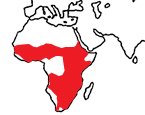|
Aardvark
(Orycteropus afer) |
||||
|
|
Physical
characteristics and distribution
|
|
Aardvark Orycteropus afer The
head and body length of the single species O. afer is
1,000 - 1,580 mm, tail length is about 443-710 mm, and shoulder
height is 600-650 mm. Adults weight between 40 - 100 kg. with
males being slightly larger than females. O. afer has
extremely thick pinkish gray skin which at times protects it
from the attacks of other animals. It is sparsely covered with
dull brownish or yellowish gray bristly hairs, the color being
slightly darker on the limbs. There are numerous vibrissae on
the face and around the muzzle and eyes. The
Aardvark has a massive body, somewhat resembling a medium to
large sized pig. The head and snout are long, ending in a blunt
muzzle with round nostrils. Curved white hairs, 25-50 mm long,
grow from the nostrils. The ears are 150-210 mm long, and are
tubularly shaped, folding back to exclude dirt when the animal
is digging. The tongue is tapered and usually hangs out of the
mouth with the end coiled. O. afer is built for digging.
The neck is short and thick, the forelegs low and the back is
arched. The long tapering tail is muscular, and the long, blunt
claws are well suited to burrowing. All of the digits are webbed,
four on the front feet and five on the back. Females have two
pair of mammae, one inguinal and one abdominal. The penis of
the male aardvark has a fold of skin which covers scent glands
at its base. The ordinal name 'Tubulidentata' derives from the physiology of the teeth. They do not grow simultaneously, but develop first in the front of the jaw. These teeth fall out about the time the animal reaches maturity, and are not replaced but succeed by teeth which grow farther back, known as cheek teeth. These teeth are covered by an external layer of cement, with each tooth resembling a flat-crowned column. Many hexagonal prisms of dentine surrounding tubular pulp cavities make up each tooth. They grow continuously throughout O. afer's life and have no enamel. O. afer is found in a variety of habitats, the main requirement is the presence of sufficient quantities of ants and termites. The name Aardvark is Afrikaans for 'earth pigs' referring to the animals resemblance to pigs and its extraordinary ability to burrow with amazing speed. O. afer digs shallow burrows to find food, deeper burrows for shelter and to escape danger and extensive tunnel systems for nesting. It is not believed to have very good eyesight, but does have extremely good hearing.
The gestation period is about 7 months with one young usually
born, but occasionally twins are produced. Offspring remain
in the nest for about 2 weeks and then accompany the mother
on nightly excursions. The youngster can dig for itself at about
6 months. Sexual maturity is reached at approximately 2 years
of age. The geological range of O. afer are the savanna zones of West Africa to E Sudan, Ethiopia and Eritrea; Kenya; Somalia; N and W Uganda to Tanzania; Rwanda; N, E, and C Dem. Rep. Congo; W Angola; Namibia; Botswana; Zimbabwe; Zambia; Mozambique; and South Africa. |
|
Description
of the brain
|
|
Animal
source and preparation
|
|
|
Other
Related Resources (websites and publications)
List of Specimens | Explore Collections | Brain Sections | Brain Evolution | Brain Development | Brain Circuitry | Brain Functions | Location and Use | Related Web Sites | Contact Us | Search MSU Database | Personnel | Home



